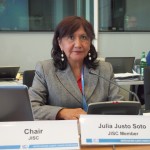Carbon Pulse Dialogues are discussions about carbon markets and climate policy by a selection of leading experts.
The UN’s Joint Implementation (JI) has long been subject to criticism over its environmental integrity and may have been dealt a knock-out blow by a study this week that found almost three-quarters of its carbon credits may not represent emission reductions.
The findings put into question some mainly eastern European countries’ efforts to ensure the carbon-cutting projects within their borders were additional compared to business as usual. They also undermine the EU’s reputation as a global leader on tackling climate change and give a stark warning for UN negotiators crafting rules on carbon markets under a new climate deal.
We asked several experts whether JI is fit only for the climate policy dustbin or does it have enough redeemable features to form the basis of an international carbon market under a Paris climate pact.
 Alexander Savelkoul: These bogus JI Track 1 credits were no news to the carbon market. Still, it is quite sad to see how emissions trading is once again identified with corruption and fraud. Some 400 million of these fake credits have been used for compliance in the EU ETS, thereby reducing its effectiveness. Demand for real emission reductions from Track 2 JI and CDM projects was crowded out by the flood of fake ERUs from Russia and Ukraine.
Alexander Savelkoul: These bogus JI Track 1 credits were no news to the carbon market. Still, it is quite sad to see how emissions trading is once again identified with corruption and fraud. Some 400 million of these fake credits have been used for compliance in the EU ETS, thereby reducing its effectiveness. Demand for real emission reductions from Track 2 JI and CDM projects was crowded out by the flood of fake ERUs from Russia and Ukraine.
The question is what the unmasking of JI Track 1 actually tells us about the merits of offsets and emissions trading as instruments to tackle climate change. The conditions that enabled the creation and usage of such a vast number of fake emission reductions were quite exceptional and are unlikely to be repeated. Russia and Ukraine had an enormous surplus of AAUs that they were trying to monetize, and found a way to do this by using the offset mechanism at their disposal (JI Track 1), which lacked any third party supervision and thus was effectively transformed into a cash machine.
Paradoxically, a future Paris Protocol, with countries adopting climate targets by way of INDCs, will be an ideal bedding for a JI-like offset trading mechanism. INDCs will result in national carbon budgets, much like the AAU budgets under Kyoto that served as the basis for JI.
It seems likely that some form of offset trading between countries will emerge again, to generate emission reductions as cost effectively as possible. History, with JI Track 1, has taught that such an offset mechanism requires independent third party supervision on the creation of offsets, for which the widely-neglected JI Track 2 can actually provide a blueprint. In addition, governments should be more vigilant and promptly ban the use of any fake offsets that might still be created.
 Stan Kolar: The SEI report may draw the correct conclusions about the lack of additionality of individual JI projects, however some of the lessons it draws for the design of future crediting mechanism are wrong.
Stan Kolar: The SEI report may draw the correct conclusions about the lack of additionality of individual JI projects, however some of the lessons it draws for the design of future crediting mechanism are wrong.
The problem of non-additional JI credits was only a temporary problem during the Kyoto Protocol period because Annex I countries as a whole had surplus AAUs during this period. Had there been no surplus, lack of additionality would not matter, because each ERU issued to a JI project leads to one AAU being cancelled by the issuing country.
An analogy is the use of surplus AAUs, which were purchased by many environmentally-conscious western European countries under a Green Investment Scheme for Kyoto compliance. These AAUs were sold with the explicit understanding by the purchasing country that, most of the time, an AAU purchased would not result in one tonne of emissions reductions, as long as there were other co-benefits, such as conventional pollution reduction, social benefits, etc. Thus, most AAUs sold under the Green Investment Scheme would not pass the additionality test in terms of GHG reductions.
And for good reason. Additionality should not be a test of environmental integrity for a project crediting mechanism, as long as these emission credits are traded within a compliance bubble, such as Annex I of the Kyoto Protocol, and the expected future developed-country bubble under a post-Paris regime. Tests of additionality would only add costs and result in no benefits.
Non-additional credits may increase emissions in any one project, but will have no effect on developed countries complying with emission reduction goals. The primary purpose of flexible emissions trading mechanisms is not necessarily to reduce emissions through projects, but to make compliance cheaper. The integrity of the whole system should be assured by a robust MRV system at the national level, not by unnecessary and costly bureaucracy at the project level.
 Wytze van der Gaast: During the negotiations on the modalities of the Kyoto Protocol’s flexibility mechanisms, the decision on two separate JI tracks was an important breakthrough. Annex I parties with a good greenhouse gas bookkeeping system could use the more flexible JI Track 1 system. This meant that no external validation and verification under the UNFCCC was required. Should a JI host country flaunt the baseline and additionality rules then this would appear in the Kyoto Protocol bookkeeping as a mistake to be corrected.
Wytze van der Gaast: During the negotiations on the modalities of the Kyoto Protocol’s flexibility mechanisms, the decision on two separate JI tracks was an important breakthrough. Annex I parties with a good greenhouse gas bookkeeping system could use the more flexible JI Track 1 system. This meant that no external validation and verification under the UNFCCC was required. Should a JI host country flaunt the baseline and additionality rules then this would appear in the Kyoto Protocol bookkeeping as a mistake to be corrected.
From JI’s practice, SEI concludes that two important host countries (Russia and Ukraine) have enabled the selling of non-additional emission reductions to foreign investors as carbon credits and that, apparently, the Kyoto Protocol bookkeeping procedures could not prevent that. The good news from the report is that most other JI host countries have performed reasonably well. The bad news is that many EU installations seem have purchased carbon credits that were not backed up by real emission reductions.
In my view, this does not mean that JI as a mechanism has failed. However, it does show that without a strict carbon accounting regime and compliance procedures, JI Track 1 without external validation and verification is not wise. Linking project-level accounting procedures with national-level climate bookkeeping systems is nice in theory but a big challenge in practice.
Current climate negotiations towards Paris go in a direction that countries are free to select their policy instruments for implementing their intended climate measures. When looking at currently emerging emissions trading schemes around the world, including the pilot schemes in China, mechanisms like JI or CDM are likely to remain important as offsetting mechanisms. Without an international AAU scheme such as under Kyoto, all these offsetting schemes will require external verification. In light of the SEI report, that’s actually good news.
 Eva Filzmoser: Joint Implementation has suffered from poor oversight and quality for a long time. The findings of the SEI study are shocking but not surprising because it was always known that the countries with most surplus AAUs under Kyoto issued most JI offsets.
Eva Filzmoser: Joint Implementation has suffered from poor oversight and quality for a long time. The findings of the SEI study are shocking but not surprising because it was always known that the countries with most surplus AAUs under Kyoto issued most JI offsets.
This is not a coincidence. While countries with stringent targets have had to trade their ERUs relatively carefully, Russia and Ukraine had no incentives to limit issuance because they had millions of spare AAUs and would still meet their Kyoto targets.
The study finally provides evidence that this surplus combined with the weak JI rules, especially under Track 1, has made it possible for Russia and Ukraine to print a huge amount of carbon offsets. These findings must raise alarm bells for the Paris climate talks where the same issues will be at stake. One big lesson from the JI is that we need to avoid the build-up of hot air (and the carry-over of pre-2020 credits for that matter) in the Paris treaty by all means. Without strict rules on accounting and participation requirements for markets that assess the stringency levels of the targets to avoid new hot air, we will likely see the same problem happen again.
 Julia Justo Soto: Addressing climate change will take a great deal of investment and active engagement by the private sector. That’s why markets and market mechanisms are a critical component in the international response to climate change. We need better mechanisms, not fewer mechanisms.
Julia Justo Soto: Addressing climate change will take a great deal of investment and active engagement by the private sector. That’s why markets and market mechanisms are a critical component in the international response to climate change. We need better mechanisms, not fewer mechanisms.
The study by SEI focuses on JI Track 1. That part of JI that is not subject to international oversight, but is instead left up to the individual countries to administer and ensure integrity. The Joint Implementation Supervisory Committee (JISC), of which I am Chair, administers and provides effective international oversight to JI Track 2.
This is a critical distinction, and supports the recommendation of the JISC, made to countries first in 2011, that JI in future be run under a single track with international oversight. Actually, since 2012 there has been a consensus by countries in the formal review of the JI rules that in future the mechanism should indeed be run under a single track with international oversight.
Building on this consensus for a single track with international oversight to ensure environmental integrity, and with the help of the JISC, this mechanism will evolve and improve. The international community has only a few effective tools to incentivize private-sector investment in climate change mitigation. The JI mechanism is one of them.
Compiled by Ben Garside and Mike Szabo – news@carbon-pulse.com




